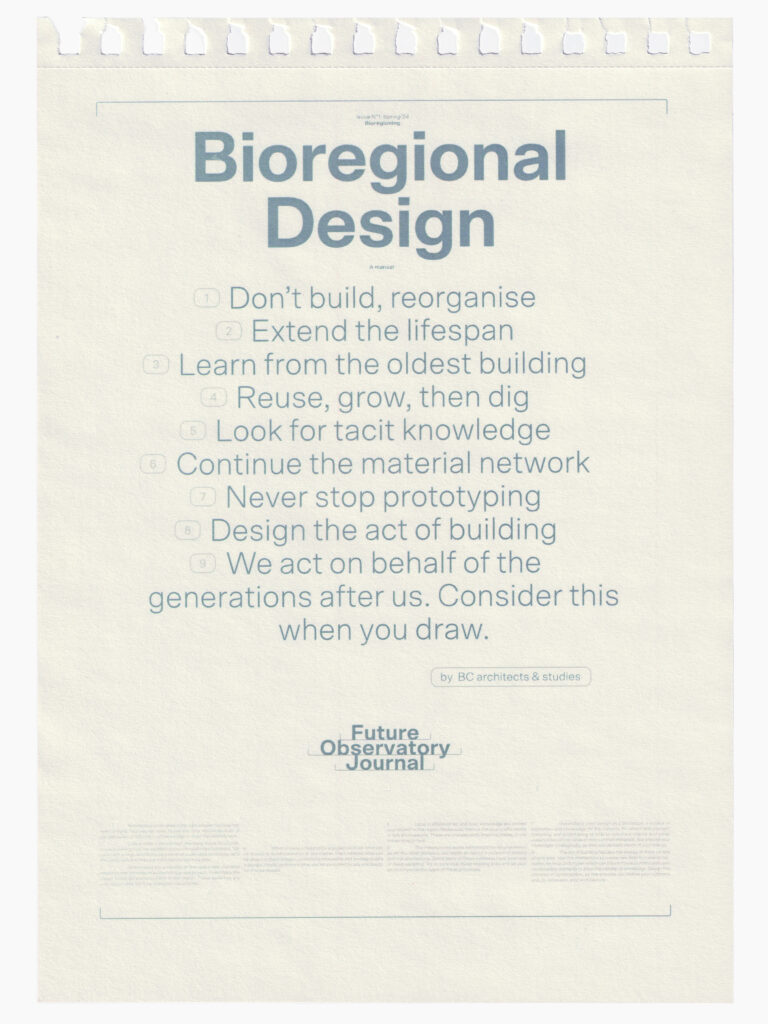A Manual for Bioregional Design
This manual provides a practical set of guidelines, precepts and pieces of advice for designing with the bioregion in mind. Read online or print out the manual and stick it on the wall of your studio.

Don’t build, reorganise
Architecture is not always the right answer. You may not need to build. You may not need to use any local resources at all. A reorganisation of functions can be enough to make the existing work.
Extend the lifespan
Look at what is already built and reuse these structures. Unused buildings can be adapted to accommodate new functions. We have such a large and continuous stock of underused structures, let’s efficiently use and improve them before anything else.
Learn from the oldest building
Understand the potential of the resources, material networks and techniques surrounding a new project. Investigate the oldest buildings and structures in the region. These buildings are archives of what the local bioregion can provide.
Reuse, grow, then dig
When choosing a material for a project, first ask what can be reused, to avoid extraction of new matter. Then consider what can be grown in the bioregion, prioritising reneweble and biodegradable materials. Finally, determine what can be excavated locally and design for it to be reused.
Look for tacit knowledge
Local crafts(wo)men and their knowledge will embed your project in the region. Rediscover them in the local crafts centre or folk art museums. These are unexpectedly inspiring places, if one knows how to look.
Continue the material network
The materials one works with should not be understood as off-the-shelf products, but rather as part of a network of actions and transformations. Some parts of those networks have been lost or need updating. Try to conceive these missing links and let your architecture be the agent of these processes.
Never stop prototyping
Understand your design as a prototype, a source of inspiration and knowledge for the industry, for others and yourself. Sampling and prototyping is vital to convince clients and other stakeholders of the value of non-certified materials. But choose your challenges strategically, as they will demand much of your energy.
Design the act of building
The act of building focuses the energy of many people on one goal. Use this momentum to create new links in material networks, develop prototypes which can inform future builders and open construction moments to allow the transfer of knowledge. Design this process of construction, as the process can define your outcome and, by extension, your architecture.
We act on behalf of the generations after us. Consider this when you draw.
For each issue of the Future Observatory Journal we commission a manual. This is intended as a practical set of guidelines, precepts or pieces of advice from design and research practitioners who work in dialogue with the issue’s theme. The manual can be read online, or printed out and stuck on your studio wall in the form of a bespoke poster designed by Studio Airport.
This issue we commissioned BC architects & studies & materials, a multifaceted practice based in Brussels who work as architects, as well as an education laboratory and material production cooperative. BC has an explicitly bioregional practice, often experimenting with locally sourced materials and knowledge to make their projects, which include LOT 8, the new Atelier LUMA building in Arles, completed with Assemble in 2023.